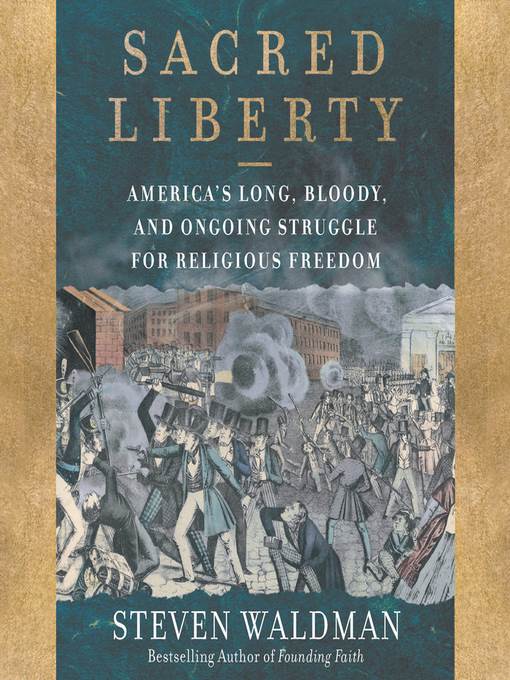
Sacred Liberty
America's Long, Bloody, and Ongoing Struggle for Religious Freedom
کتاب های مرتبط
- اطلاعات
- نقد و بررسی
- دیدگاه کاربران
نقد و بررسی

March 11, 2019
Waldman (Founding Faith), founder of multifaith website Beliefnet, offers a fine overview of the growth of religious freedom in the United States. While the framers of the U.S. Constitution debated the place of religious freedom, it was James Madison, Waldman writes, who championed the separation of church and state and, in particular, the idea that states could not establish an official faith. Waldman details how Native Americans, Mormons, Jehovah’s Witnesses, and Jews later looked to Madison’s ideas in order to argue for equal treatment. It was not until after WWII that religious freedoms taken for granted today were established as the result of pressure placed on the political (particularly from Catholic groups, who organized diverse coalitions into voting blocks) and legal systems (including 23 Jehovah’s Witnesses cases argued in front of the Supreme Court between 1938 and 1946) to widen concepts of religious freedom to include the freedom of public religious expression and protections guarding against religious bias. Waldman makes a brief argument that common sense should prevail over legal battles, citing the Colorado case against a baker who refused to sell to an LGBTQ customer as an example of the legal system reaffirming common sense practices. General readers of American history will find much to enjoy in Waldman’s exploration of the evolution of American religious freedoms.

April 1, 2019
An energetic pop history surveys America's commitments to religious liberty from the 17th century to the present. As journalist and Beliefnet co-founder Waldman (Founding Faith: Providence, Politics, and the Birth of Religious Freedom in America, 2008, etc.) shows, whatever you may have learned in elementary school about the Puritans, the Colonies were hardly bastions of religious freedom; in fact, using executions and arrests, English leaders harshly enforced various ecclesial establishments. It wasn't until the American Revolution that the Founding Fathers crafted norms of religious liberty. James Madison is the star of Waldman's account; Thomas Jefferson shows up for his 1801 use of the phrase "wall of separation between Church & State," but the author pays too little attention to his important role in pushing for religious toleration in revolutionary Virginia. The late-18th- and early-19th-century articulations of religious freedom were the true beginning of the story. In the decades that followed, many groups, including Catholics, Latter-day Saints, and Jehovah's Witnesses, prodded the nation to further embody its ideals of religious liberty. As late as 1942, Franklin Roosevelt opined that America was "a Protestant country and the Catholics and Jews are here under sufferance." Indeed, as Waldman's especially helpful discussion of the post-World War II landscape demonstrates, the 1940s brought a new push for interfaith understanding--Amy Vanderbilt's etiquette guide included a chapter on it--as a sort of generic, pluralist faith was marshalled as a counter to communism. The 1940s also saw the Supreme Court taking a more expanded role defining religious freedom; in earlier decades, argues the author, the shape of religious liberty was largely left up to local governments. Turning to the present, Waldman suggests how anti-Islamic sentiment among non-Muslim Americans provides a way of assessing the reach and the limits of America's commitment to religious pluralism. Armchair historians who can tolerate Waldman's occasional stylistic indulgences--e.g., dramatic single-sentence paragraphs, breathless ellipses, lengthy block quotes--will be rewarded with an informative account.
COPYRIGHT(2019) Kirkus Reviews, ALL RIGHTS RESERVED.

Starred review from April 15, 2019
In this highly accessible popular history, Beliefnet cofounder Waldman tells the story of the First Amendment's religion clauses, concluding with a set of principles for keeping American religious freedom vital. The history is often one of the country's many shameful episodes of religious persecution, beginning with the Puritan execution of Quaker Mary Dyer on Boston Common in 1660. A century later, young James Madison was so mortified by the way Virginia Anglicans assaulted Baptist preachers that it eventually provoked the religion clauses out of him, though they were watered down from his originals, which had spelled out that neither state nor federal governments could establish a church or inhibit religious practice. Baptists and Methodists first and later Catholic and Jewish immigrants as well as homegrown Mormons and Jehovah's Witnesses were legally persecuted and worse. (The nadir of persecution was of Native American religions.) In 1865, the Fourteenth Amendment finally extended the clauses' injunctions to the states, but then judges, used to states' rights, didn't start applying the Fourteenth until the twentieth century, when cases brought by the Witnesses, in particular, spurred the Supreme Court to obey the Constitution. Islam in America advanced comfortably until 9/11, after which persecution of it became the latest threat to religious freedom. Waldman points out that Madison's contention that religion thrives when government neither favors nor encumbers particular sects has proven itself. A fascinating look at an important piece of history.(Reprinted with permission of Booklist, copyright 2019, American Library Association.)

























دیدگاه کاربران